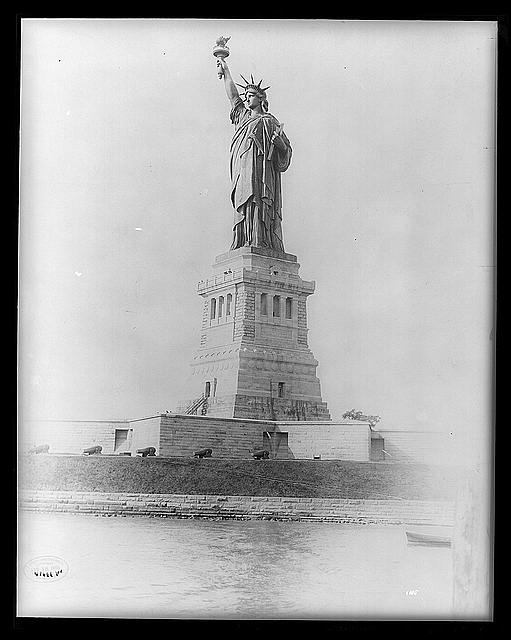Statue of Liberty Base
1886 (dedicated)
Richard Morris Hunt,
architect
Jpg: Library
of Congress
The Statue of Liberty was a gift
from the people of France to the people of the United States. The monument's
intent was to celebrate the centennial of the American Declaration of Independence,
which was in 1876. The sculptor was Frederic-Auguste Bartholdi's and his
creation: "Liberty Enlightening the World," the proper full name of the
statue, stands more than 300 feet high.
Parts of it were finished by 1876
but Americans had no place to put it nor the money to erect it. A private
campaign was organized and by 1885 the funds were in place to complete
it.
To get it from France to America,
the figure was disassembled into 350 pieces and packed in 214 crates and
arrived in New York Harbor on June 19, 1885. It was reassembled on Bedloe's
Island (renamed Liberty Island in 1956). On October 28, 1886, President
Grover Cleveland dedicated the Statue of Liberty before thousands of spectators.
The base is instrumental, not only
as a decorative part of the statue, but also important in the structural
element of this colossal giant. The sculpture is made of copper sheets
which are assembled on a framework of iron grid designed by bridge builder
Alexandre-Gustave Eiffel (who would in turn design the Eiffel tower for
Paris some 13 years later). The interior structure sinks deep into the
base which gives it support and strength to withstand any Atlantic storms.
At the base of the pedestal is inscribed
the poem that Americans thought best depicted this generous gift:
"The New Colossus"
Not like the brazen
giant of Greek fame,
With conquering limbs
astride from land to land; Here at our sea-washed, sunset gates shall
stand
A mighty woman with
a torch, whose flame
Is the imprisoned lightning,
and her name
Mother of Exiles. From
her beacon hand
Glows world-wide welcome;
her mild eyes command The air-bridged harbor that twin cities frame.
"Keep, ancient lands,
your storied pomp!" cries she With silent lips. "Give me your tired, your
poor,
Your huddled masses
yearning to breathe free,
The wretched refuse
of your teeming shore.
Send these, the homeless,
tempest-tost to me,
I lift my lamp beside
the golden door.
Emma Lazarus, 1883
And come they did. Shortly after the
opening of the nearby Ellis Island Immigration Station in 1892, more than
twelve million immigrants passed by "Lady Liberty" as their first sight
of their new home. It would change the face of New York city. The whole
immigrant movement would change the face of the entire nation and once
again redefine who we are as a people. From 1800 until World War I, the
United States grew from five million to one hundred and six million people.
"Lady Liberty" was -- and is -- a personification of a collective American
dream: that we are a melting pot of free people, self governing, united
by a common guiding flame -- the Jeffersonian principles of life,
liberty and the pursuit of happiness.
Notes:
|




